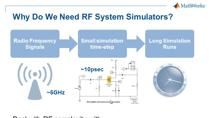6G Wireless Technology: Accelerate Your R&D with MATLAB
The world of wireless communications has begun the research and development to build sixth-generation (6G) wireless systems. 6G research and development aims to improve on the performance of the current 5G systems and develop networks that are faster, more intelligent, operate with lower latencies, and enable new applications. Enabling technologies for 6G may include new frequencies like sub-THz communication, as well as artificial intelligence and machine learning, reconfigurable intelligent surfaces, joint communication and sensing, and new digital waveforms. Hear an overview of the goals and vision for 6G systems, the enabling technologies, and how MATLAB® wireless communications tools can enable you to accelerate your 6G R&D process with reliable modeling and simulation.
Published: 3 May 2023




